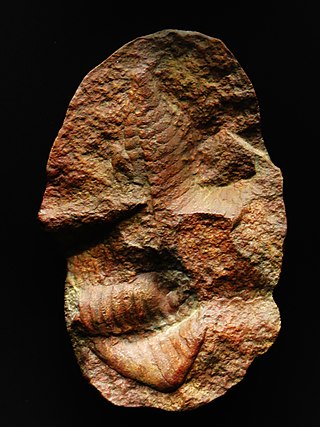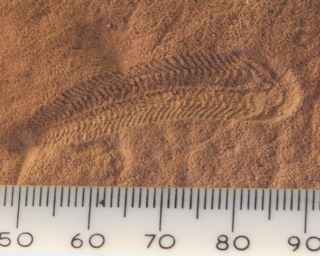
The Ediacaran is a geological period of the Neoproterozoic era that spans 96 million years from the end of the Cryogenian period at 635 Mya to the beginning of the Cambrian period at 538.8 Mya. It is the last period of the Proterozoic eon as well as the last of the so-called "Precambrian supereon", before the beginning of the subsequent Cambrian period marks the start of the Phanerozoic eon, where recognizable fossil evidence of life becomes common.

The Proterozoic is the third of the four geologic eons of Earth's history, spanning the time interval from 2500 to 538.8 Mya, the longest eon of the Earth's geologic time scale. It is preceded by the Archean and followed by the Phanerozoic, and is the most recent part of the Precambrian "supereon".

Pteridinium is an erniettomorph found in a number of Precambrian deposits worldwide. It is a member of the Ediacaran biota.

Dickinsonia is a genus of extinct organism, most likely an animal, that lived during the late Ediacaran period in what is now Australia, China, Russia and Ukraine. It is one of the best known members of the Ediacaran biota. The individual Dickinsonia typically resembles a bilaterally symmetrical ribbed oval. Its affinities are presently unknown; its mode of growth has been considered consistent with a stem-group bilaterian affinity, though various other affinities have been proposed. The discovery of cholesterol molecules in fossils of Dickinsonia lends support to the idea that Dickinsonia was an animal, though these results have been questioned.

The Doushantuo Formation is a geological formation in western Hubei, eastern Guizhou, southern Shaanxi, central Jiangxi, and other localities in China. It is known for the fossil Lagerstätten in Zigui in Hubei, Xiuning in Anhui, and Weng'an in Guizhou, as one of the oldest beds to contain minutely preserved microfossils, phosphatic fossils that are so characteristic they have given their name to "Doushantuo type preservation". The formation, whose deposits date back to the Early and Middle Ediacaran, is of particular interest because it covers the poorly understood interval of time between the end of the Cryogenian geological period and the more familiar fauna of the Late Ediacaran Avalon explosion, as well as due to its microfossils' potential utility as biostratigraphical markers. Taken as a whole, the Doushantuo Formation ranges from about 635 Ma at its base to about 551 Ma at its top, with the most fossiliferous layer predating by perhaps five Ma the earliest of the 'classical' Ediacaran faunas from Mistaken Point on the Avalon Peninsula of Newfoundland, and recording conditions up to a good forty to fifty million years before the Cambrian explosion at the beginning of the Phanerozoic.

Kimberella is an extinct genus of bilaterian known only from rocks of the Ediacaran period. The slug-like organism fed by scratching the microbial surface on which it dwelt in a manner similar to the gastropods, although its affinity with this group is contentious.

The rangeomorphs are a form taxon of frondose Ediacaran fossils that are united by a similarity to Rangea. Some researchers, such as Pflug and Narbonne, suggest that a natural taxon Rangeomorpha may include all similar-looking fossils. Rangeomorphs appear to have had an effective reproductive strategy, based on analysis of the distribution pattern of Fractofusus misrai, which consisted of sending out a waterborne asexual propagule to a distant area, and then spreading rapidly from there, just as plants today spread by stolons or runners.

Spriggina is a genus of early bilaterian animals whose relationship to living animals is unclear. Fossils of Spriggina are known from the late Ediacaran period in what is now South Australia. Spriggina floundersi is the official fossil emblem of South Australia; it has been found nowhere else.

Vendobionts or Vendozoans (Vendobionta) are a proposed very high-level, extinct clade of benthic organisms that made up of the majority of the organisms that were part of the Ediacaran biota. It is a hypothetical group and at the same time, it would be the oldest of the animals that populated the Earth about 580 million years ago, in the Ediacaran period. They became extinct shortly after the so-called Cambrian explosion, with the introduction of fauna formed by more recognizable groups and more related to modern animals. It is very likely that the whole Ediacaran biota is not a monophyletic clade and not every genus placed in its subtaxa is an animal.

Swartpuntia is a monospecific genus of erniettomorph from the terminal Ediacaran period, with at least three quilted, leaf-shaped petaloids — probably five or six. The petaloids comprise vertical sheets of tubes filled with sand. Swartpuntia specimens range in length from 12 to 19 cm, and in width from 11.5 to 140 cm. The margin is serrated, with a 1 mm wide groove. A 14 mm wide stem extends down the middle, tapering towards the top, and stopping 25 mm from the tip. The stem has a V-shaped ornamentation on it. The original fossils were found at, and named after, the Swartpunt farm between Aus and Rosh Pinah in Namibia. The generic name comes from Swartpunt, meaning black point in reference to the colour of the rocks. The specific name germsi honours Gerard Germs, who studied the Nama formation of geological beds.

The Ediacaranbiota is a taxonomic period classification that consists of all life forms that were present on Earth during the Ediacaran Period. These were enigmatic tubular and frond-shaped, mostly sessile, organisms. Trace fossils of these organisms have been found worldwide, and represent the earliest known complex multicellular organisms. The term "Ediacara biota" has received criticism from some scientists due to its alleged inconsistency, arbitrary exclusion of certain fossils, and inability to be precisely defined.
The end-Ediacaran extinction is a mass extinction believed to have occurred near the end of the Ediacaran period, the final period of the Proterozoic eon. Evidence suggesting that such a mass extinction occurred includes a massive reduction in diversity of acritarchs, the sudden disappearance of the Ediacara biota and calcifying organisms, and the time gap before Cambrian organisms "replaced" them. Some lines of evidence suggests that there may have been two distinct pulses of the extinction event, one occurring 550 million years ago and the other 539 million years ago.
The Cambrian explosion is an interval of time approximately 538.8 million years ago in the Cambrian period of the early Paleozoic when there was a sudden radiation of complex life, and practically all major animal phyla started appearing in the fossil record. It lasted for about 13 to 25 million years and resulted in the divergence of most modern metazoan phyla. The event was accompanied by major diversification in other groups of organisms as well.
Ediacaran type preservation relates to the dominant preservational mode in the Ediacaran period, where Ediacaran organisms were preserved as casts on the surface of microbial mats.

The Erniettomorphs are a form of Ediacaran fossil consisting of rows of airbed-like tubes arranged along a midline with a glide symmetry. Representative genera include Ernietta, Phyllozoon, Pteridinium, Swartpuntia. Undisputed Erniettomorphs were Ediacaran, but the species Erytholus, Rutgersella, and Protonympha, who have by some been included in this group but are by no means clear members, are found through to the Late Devonian. Their affinity is uncertain; they probably form a clade and are most likely a sister group to the rangeomorphs, which bear a similar construction. Placements within the metazoan crown-group have been rebutted, and it is most likely that these peculiar organisms lie in the stem group to the animals. There is no evidence that they possessed a mouth or gut. Because they may have been found in water which was too deep to permit photosynthesis – and in some cases, lived half-buried in sediment, it is speculated that they fed by osmosis from the sea water. Such a lifestyle requires a very high surface area to volume ratio – higher than is observed in fossils. However, this paradox can be resolved if much of the volume of the organisms was not metabolically active. Many Pteridinium fossils are found completely filled with sand; if this sand were present within the organism while it was alive, this would reduce its metabolically active volume enough to make osmotic feeding viable.

The Mistaken Point Formation is a geologic formation in Newfoundland and Labrador. It is recognized as a Lagerstätte preserving fossils dating back to the Ediacaran period. It contains a stratum dated to 565 ± 3 million years ago.

The petalonamids (Petalonamae) are an extinct group of archaic animals typical of the Ediacaran biota, also called frondomorphs, dating from approximately 635 million years ago to 516 million years ago. They are benthic and motionless animals, that have the shape of leaves, fronds (frondomorphic), feathers or spindles and were initially considered algae, octocorals or sea pens. It is now believed that there are no living descendants of the group, which shares a probable relation to the Ediacaran animals known as Vendozoans.

Ikaria wariootia is an early example of a wormlike, 2–7 mm-long (0.1–0.3 in) bilaterian organism. Its fossils are found in rocks of the Ediacara Member of South Australia that are estimated to be between 560 and 555 million years old. A representative of the Ediacaran biota, Ikaria lived during the Ediacaran period, roughly 15 million years before the Cambrian, when the Cambrian explosion occurred and where widespread fossil evidence of modern bilaterian taxa appear in the fossil record.
Shuhai Xiao is a Chinese-American paleontologist and professor of geobiology at Virginia Tech, Blacksburg, Virginia, U.S.A.

















